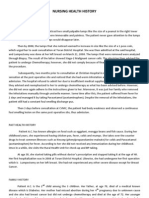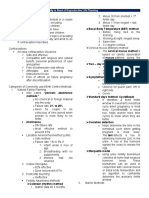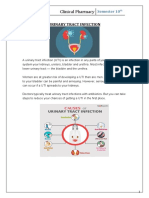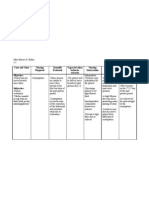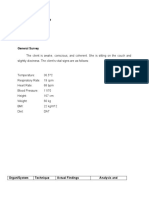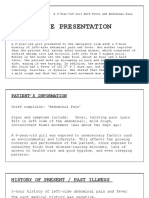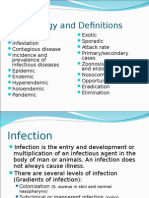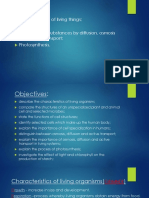0 ratings0% found this document useful (0 votes)
320 viewsCase Study AGE With Signs of Dehydration
Case Study AGE With Signs of Dehydration
Uploaded by
ZhenmeiThe document provides information about a case study of a 9 year old female patient, BB, admitted to the hospital with acute gastroenteritis with signs of dehydration. Some key details include:
- BB presented with vomiting and watery green stool and was initially treated at a local health center before being brought to the hospital.
- Her past medical history and family history were noncontributory.
- In the hospital, she had decreased appetite and continued diarrhea and vomiting. Nursing assessments were performed and care plans developed.
- The case study aims to provide knowledge of acute gastroenteritis and appropriate nursing care for the condition.
Copyright:
© All Rights Reserved
Available Formats
Download as PDF, TXT or read online from Scribd
Case Study AGE With Signs of Dehydration
Case Study AGE With Signs of Dehydration
Uploaded by
Zhenmei0 ratings0% found this document useful (0 votes)
320 views27 pagesThe document provides information about a case study of a 9 year old female patient, BB, admitted to the hospital with acute gastroenteritis with signs of dehydration. Some key details include:
- BB presented with vomiting and watery green stool and was initially treated at a local health center before being brought to the hospital.
- Her past medical history and family history were noncontributory.
- In the hospital, she had decreased appetite and continued diarrhea and vomiting. Nursing assessments were performed and care plans developed.
- The case study aims to provide knowledge of acute gastroenteritis and appropriate nursing care for the condition.
Original Description:
AGE with signs of Dehydration
Copyright
© © All Rights Reserved
Available Formats
PDF, TXT or read online from Scribd
Share this document
Did you find this document useful?
Is this content inappropriate?
The document provides information about a case study of a 9 year old female patient, BB, admitted to the hospital with acute gastroenteritis with signs of dehydration. Some key details include:
- BB presented with vomiting and watery green stool and was initially treated at a local health center before being brought to the hospital.
- Her past medical history and family history were noncontributory.
- In the hospital, she had decreased appetite and continued diarrhea and vomiting. Nursing assessments were performed and care plans developed.
- The case study aims to provide knowledge of acute gastroenteritis and appropriate nursing care for the condition.
Copyright:
© All Rights Reserved
Available Formats
Download as PDF, TXT or read online from Scribd
Download as pdf or txt
0 ratings0% found this document useful (0 votes)
320 views27 pagesCase Study AGE With Signs of Dehydration
Case Study AGE With Signs of Dehydration
Uploaded by
ZhenmeiThe document provides information about a case study of a 9 year old female patient, BB, admitted to the hospital with acute gastroenteritis with signs of dehydration. Some key details include:
- BB presented with vomiting and watery green stool and was initially treated at a local health center before being brought to the hospital.
- Her past medical history and family history were noncontributory.
- In the hospital, she had decreased appetite and continued diarrhea and vomiting. Nursing assessments were performed and care plans developed.
- The case study aims to provide knowledge of acute gastroenteritis and appropriate nursing care for the condition.
Copyright:
© All Rights Reserved
Available Formats
Download as PDF, TXT or read online from Scribd
Download as pdf or txt
You are on page 1of 27
Bulacan State University
City of Malolos, Bulacan
College of Nursing
Case Study of Patient with Acute
Gastroenteritis
Submitted by:
Calma, Therese Josephine
Censon, Luwalhati
BSN 3D
Submitted to:
Maribel Valencia, R.N.
I. INTRD!CTIN
"#ute $astroenteritis
Acute Gastroenteritis is inflammation of the gastrointestinal tract, involving both the stomach and the small intestine and resulting in
acute diarrhea !he inflammation is caused most often by infection with certain viruses, less often by bacteria or their to"ins, #arasites, or
adverse reaction to something in the diet or medication At least $%& of cases of gastroenteritis as foodborne illness are due to norovirus
Another '%& of cases, and the ma(ority of severe cases in children, are due to rotavirus )ther significant viral agents include adenovirus
and
astrovirus
*ifferent s#ecies of bacteria can cause gastroenteritis, including Salmonella, Shigella, Staphylococcus, Campylobacter jejuni,
Clostridium, Escherichia coli, Yersinia, and others +ach organism causes slightly different sym#toms but all result in diarrhea Colitis,
inflammation of the large intestine, may also be #resent Some ty#es of acute gastroenteritis will not resolve without antibiotic treatment,
es#ecially when bacteria or e"#osure to #arasites are the cause Physicians may want to diagnose the cause by analy,ing a stool sam#le,
when stomach sym#toms remain #roblematic
-orldwide, inade.uate treatment of gastroenteritis /ills $ to 0 million #eo#le #er year and is a leading cause of death among infants
and children under $ !he most common sym#toms are diarrhea, vomiting and stomach #ain, because whatever causes the condition inflames
the gastrointestinal tract Another reason to see/ medical treatment is that some forms of acute gastroenteritis mimic a##endicitis, which may
re.uire emergency treatment As well, young children run an es#ecially high ris/ of becoming dehydrated during a long course of the stomach
flu )ne should receive directions regarding how to hel# affected /ids or adults get more fluids Sometimes children, those with com#romised
immune systems, and the elderly may re.uire hos#itali,ation and intravenous fluids *ehydration can actually cause greater nausea, and can
begin to cause organ shut down if not #ro#erly addressed
Acute gastroenteritis is .uite common among children, though it is certainly #ossible for adults to suffer from it as well -hile most
cases of gastroenteritis last a few days, acute gastroenteritis can last for wee/s and months
Acute gastroenteritis remains a serious health issue, and is res#onsible for over $%,%%% hos#itali,ations of children 1n develo#ing
countries, acute gastroenteritis is the leading cause of death for infants Acute gastroenteritis should thus be ta/en seriously, and #eo#le
should not hesitate to see/ medical treatment for es#ecially seniors and children who have been ill for more than a day
1n the Phili##ine 2ealth Statistic, gastroenteritis range as number 3% in the ten leading causes of infant mortality, with the rate of %$
and #ercentage of 43 cases in the Phili##ines by the year '%%4 this was u#dated last 5ebruary 3', '%%0
Signifi#an#e of the stu%&'
his study will enable the students to understand better about acute gastroenteritis and will e"#lain the different ris/ factors for
develo#ing the disease, including consum#tion of im#ro#erly #re#ared foods or contaminated water and travel or residence in areas of #oor
sanitation Since we are client6centered, we really should consider our #atient7s comfort and this study will give the students sufficient
/nowledge that will hel# them to #lan and im#lement nursing care #lans that will satisfy #atient7s needs
II. BJ(CTI)(S'
". $eneral *+e#ti,es
!his study aims to convey familiarity and to #rovide an effective nursing care to a #atient diagnosed with Acute Gastroenteritis through
understanding the #atient history, disease #rocess and management
B. Spe#ifi# *+e#ti,es
3 !o #resent a thorough assessment, through 8ursing 2ealth 2istory, Gordon7s !y#ology 33 5unctional Pattern, Physical Assessment, and
the inter#retation of the laboratory e"amination done on the #atient
' !o discuss the anatomy and #hysiology, #atho#hysiology of the #atient7s condition, usual clinical manifestations and #ossible com#lications
of this condition
9 !o have /nowledge to the client medication and be familiar to that medication
4 !o formulate a wor/able nursing care #lan on the sub(ective and ob(ective cues gathered through nurse6#atient interaction to be able to
hel# the #atient recover
III. -"TI(NT.S -R/IL(
". Biographi#al Data
*ate: :uly 3;, '%%< Clinical Area : Pedia ward room '%'
Name ' Ms BB
Address ' San 1sidro 11, Paombong, Bulacan
Date of Birth ' 8ovember $, '%%$
Age ' 9 = years old
Sex ' 5emale
Civil Status ' Single
Nationality ' 5ili#ino
eligious !references ' Born Again Christian
"ealth care financing ' Philhealth and 5inancial health assistance from baranggay health center
Date of Admission ' :uly 3$, '%%<
Diagnosis : Acute Gastroenteritis with signs of dehydration
B. Chief Complaint
According to the significant others, the client was vomiting and defecating that7s why they rushed her to the hos#ital
I). 0("LT0 0ISTR1
". 0istor& of -resent Illness
Prior to admission, the client was vomiting and defecating 2er stool was watery and its color is green At first, they to the baranggay
health center and the midwife gave them medication According to the midwife, the medication is for >BM, but after drin/ing the medication,
the client was still defecating and vomiting so the family decided to rush the client at +milio G Pere, Memorial *istrict 2os#ital the ne"t day
B. -ast 0istor&
!he client had fever, cough and colds She had com#leted all vaccinations including BCG, *P!, )ral Polio ?accine, MM@ and
2e#atitis B vaccine !he #atient had never been any of the childhood disease such as measles, mum#s and chic/en #o" !he #atient had
no history of accident or any in(ury She does not have allergy in any food or drug She was not hos#itali,ed before and she does not ta/e any
medication or su##lements to maintain her health
C. /amil& 0istor&
According to the significant others of BB they have a familial disease of asthma, both on her father and motherAs side And an incident
of hy#ertension on his fatherAs side
$enogram'
Legends
+C
$$ yBo
2P8
>B
$4 yBo
?B
99 yBo
>P
9' yBo
AS!2
CM
93 yBo
MB
'< yBo
>)
9$ yBo
AS!2
PC
93 yBo
:B
'0 yBo
2+
'9 yBo
AS!2
+B
$;yBo
2P8
@C
$D yBo
-aternal 2aternal
CB
1 y/o
BB
3 y/o
:C
'%yBo
AC
'' yBo
"CTI)ITI(S / D"IL1 LI)IN$
/un#tional 0ealth -er#eption -rior to 0ospitali3ation During 0ospitali3ation
Nutritional 2eta*oli# -attern
E !he client eats four times a day
including brea/fast, lunch, merienda and
dinner According to the significant others,
she always eats rice and sou# She can
drin/ 4 glasses of water in a day She has
no eating discomforts She does not have
any dental #roblems because she has a
com#lete set of teeth
9 days food recall
:uly 33
9 cu#s rice
9 cu#s sou#
4 glasses of
water
:uly 3'
9 cu#s rice
3 #iece of egg
= #iece #a/siw
na bangus
9 glasses of
water
:uly 39
9 cu#s rice
9 cu#s sou#
' #ices of
bread
4 glasses of
water
F !he client seldom eats at the hos#ital She does
not have a##etite for eating She seldom drin/s
water or other fluids
9 days food recall
:uly 34
' cu#s rice
3 bowl of
sinigang
sou#
' glasses of
water
:uly 3$
3 glass of water
:uly 3;
' #ieces
#on/an
= glass of
water
(limination -attern
"#ti,it&4e5er#ise -attern
Sleep4rest -attern
E !he client defecates everyday and her
stool is soft but formed and its color is
brown and has a foul odor She urinates
five times a day and is yellowish in color
She has no discomfort in defecating and
urinating
E !he client has sufficient energy for
com#leting her desired re.uired activities
%6 feeding
%6 clothing
116 bathing
116 grooming
E !he client slee#s about 3% hours a day
5rom 0#m to ;am She has no #roblem
falling aslee# and does not ta/e slee#
medications 2er slee# is always
continuous es#ecially when she is tired
She ta/es a na# during afternoon 5rom
3':9%#m to 9#m
E !he client defecates three times a day
2er stool is watery and its color is green
She urinates twice a day and it is yellowish
in color
E !he client does not have sufficient
energy for com#leting her desired re.uired
activities
116 feeding
116 clothing
116 bathing
116 grooming
E !he client still slee#s 3% hours a day
She only wa/es u# when her medications
are due She has no #roblem falling aslee#
and does not ta/e any slee# medications
She does not ta/e na#s
Cogniti,e4-er#eptual -attern
Role4relationship -attern
)alue4*elief -attern
E !he client does not have difficulty in
hearing and has no hearing aid According
to the significant others, whenever the
client feels #ain or any discomfort, they
always give her medications
E !he client lives with her mother, father
and grand#arents !he structure of her
family is e"tended And (ust li/e the ty#ical
family, their family has #roblems wherein
they have difficulty in handling, as stated by
the grandmother
E !he client is a born again Christian
According to the significant others, they
attend mass every Sunday
E !he client ta/es medications to relieve
any discomforts
E !he 5amily of the #atient es#ecially her
#arents are su##ortive and more caring
). D()(L-2(NT"L T"S6
(ri7 (ri7son4-s&#hoso#ial %e,elopment
!he #atient is currently in the early childhood stage G96; yBoH wherein the central tas/ is Initiati,e ,s. $uilt *uring this stage, initiative
adds to autonomy the .uality of underta/ing, #lanning, and attac/ing a tas/ for the sa/e of being active and on the move !he child is learning
to master the world around him or her, learning basic s/ills and #rinci#les of #hysicsI things fall to the ground, not u#I round things roll, how to
,i# and tie, count and s#ea/ with ease Guilt is a new emotion and is confusing to the childI he or she may feel guilty over things which are not
logically guilt #roducing, and he or she will feel guilt when his or her initiative does not #roduce the desired results At this stage the client
wants to begin and com#lete her own actions for a #ur#ose
1nter#retation: Positive @esolution
Jean -iaget8s Cogniti,e De,elopment
!he #atient is under the Pre6o#erational stage 1n this #eriod intelligence is demonstrated through the use of symbols, language use
matures, and memory and imagination are develo#ed, but thin/ing is done in a nonlogical, nonreversible manner +gocentric thin/ing
#redominates !he #atient was able to do ma/e believe #lay and able to imitate others, li/e her mother doing some household chores as
verbali,ed by the JS)J
1nter#retation: Positive @esolution
)I. -01SIC"L "SS(SS2(NT
*ate: :uly 3;, '%%< Clinical Area : Pedia ward room '%'
BD1 -"RTS
"SS(SS(D
T(C0NI9!(S NR2"L /INDIN$S "CT!"L /INDIN$S INT(R-R(T"TIN
3S/in
a Moisture Pal#ation Moisture in s/in folds and a"illae *ry s/in *eviated due to slight
dehydration
b !e"ture Pal#ation Smooth @ough *eviated due to slight
dehydration
c !urgor 1ns#ection and
Pal#ation
S#rings bac/ immediately to
#revious state
Moves bac/ slowly *eviated due to slight
dehydration
' Mouth
a >i#s
1ns#ection
Pin/ in color, soft moist, smooth
te"ture, symmetrical no
tenderness, no lesions
*ry li#s
*eviated due to slight
dehydration
bMucosa 1ns#ection and
Pal#ation
Uniform #in/ color *ry and slightly #in/ in color *eviated from normal due
to slight dehydration
c Gums 1ns#ection and
Pal#ation
Pin/ gums, moist, firm te"ture Pin/ gums, dry, firm te"ture *eviated from normal due
to slight dehydration
9 Abdomen
Bowel sounds Auscultation Audible bowel sounds 2y#eractive bowel sound *eviated due to diarrhea
)II. R()I(: I/ S1ST(2
Digesti,e S&stem
!he #rimary function of the digestive system is to brea/ down the food we eat into smaller #arts so the body can use them to build and
nourish cells and #rovide energy !here occurs #ro#ulsion which is the movement of food along the digestive tract !he ma(or means of
#ro#ulsion is #eristalsis, a series of alternating contractions and rela"ations of smooth muscle that lines the walls of the digestive organs and
that forces food to move forward 1t secretes digestive en,ymes and other substances li.uefies, ad(usts the #2 of, and chemically brea/s down
the food Mechanical digestion is the #rocess of #hysically brea/ing down food into smaller #ieces !his #rocess begins with the chewing of
food and continues with the muscular churning of the stomach Additional churning occurs in the small intestine through muscular constriction
of the intestinal wall !his #rocess, called segmentation, is similar to #eristalsis, e"ce#t that the rhythmic timing of the muscle constrictions
forces the food bac/ward and forward rather than forward only Chemical digestion which is the #rocess of chemically brea/ing down food into
sim#ler molecules !he #rocess is carried out by en,ymes in the stomach and small intestines !hen absor#tion or the movement of molecules
Gby #assive diffusion or active trans#ortH from the digestive tract to ad(acent blood and lym#hatic vessels Absor#tion is the entrance of the
digested food into the body And lastly, defecation which is the #rocess of eliminating undigested material through the anus
But because of acute gastroenteritis the normal functions were altered !he infectious agents that cause acute gastroenteritis causes
diarrhea by adherence, mucosal invasion, enteroto"in #roduction, andBor cytoto"in #roduction
!hese mechanisms result in increased fluid secretion andBor decreased absor#tion leading to diarrhea !his #roduces an increased luminal
fluid content that cannot be ade.uately reabsorbed, leading to dehydration and the loss of electrolytes and nutrients
)III. "N"T21 "ND -01SIL$1
!he human digestive system is a com#le" series of organs and glands that #rocesses food 1n order to use the food we eat, our body
has to brea/ the food down into smaller molecules that it can #rocessI it also has to e"crete waste
Most of the digestive organs Gli/e the stomach and intestinesH are tube6li/e and contain the food as it ma/es its way through the body
!he digestive system is essentially a long, twisting tube that runs from the mouth to the anus, #lus a few other organs Gli/e the liver and
#ancreasH that #roduce or store digestive chemicals
The Digesti,e -ro#ess:
The start of the pro#ess 4 the mouth' !he digestive #rocess begins in the mouth 5ood is #artly bro/en down by the #rocess of chewing and
by the chemical action of salivary en,ymes Gthese en,ymes are #roduced by the salivary glands and brea/ down starches into smaller
moleculesH
n the wa& to the stoma#h' the esophagus 6 After being chewed and swallowed, the food enters the eso#hagus !he eso#hagus is a long
tube that runs from the mouth to the stomach 1t uses rhythmic, wave6li/e muscle movements Gcalled #eristalsisH to force food from the throat
into the stomach !his muscle movement gives us the ability to eat or drin/ even when weAre u#side6down
In the stoma#h 6 !he stomach is a large, sac/6li/e organ that churns the food and bathes it in a very strong acid Ggastric acidH 5ood in the
stomach that is #artly digested and mi"ed with stomach acids is called chyme
In the small intestine 6 After being in the stomach, food enters the duodenum, the first #art of the small intestine 1t then enters the (e(unum
and then the ileum Gthe final #art of the small intestineH 1n the small intestine, bile G#roduced in the liver and stored in the gall bladderH,
#ancreatic en,ymes, and other digestive en,ymes #roduced by the inner wall of the small intestine hel# in the brea/down of food
In the large intestine 6 After #assing through the small intestine, food #asses into the large intestine 1n the large intestine, some of the water
and electrolytes Gchemicals li/e sodiumH are removed from the food Many microbes Gbacteria li/e Bacteroides, #actobacillus acidophilus,
Escherichia coli, and $lebsiellaH in the large intestine hel# in the digestion #rocess !he first #art of the large intestine is called the cecum Gthe
a##endi" is connected to the cecumH 5ood then travels u#ward in the ascending colon !he food travels across the abdomen in the
transverse colon, goes bac/ down the other side of the body in the descending colon, and then through the sigmoid colon
The en% of the pro#ess 6 Solid waste is then stored in the rectum until it is e"creted via the anus
Digesti,e S&stem $lossar&:
anus 6 the o#ening at the end of the digestive system from which feces GwasteH e"its the body
appen%i5 6 a small sac located on the cecum
as#en%ing #olon 6 the #art of the large intestine that run u#wardsI it is located after the cecum
*ile 6 a digestive chemical that is #roduced in the liver, stored in the gall bladder, and secreted into the small intestine
#e#um 6 the first #art of the large intestineI the a##endi" is connected to the cecum
#h&me 6 food in the stomach that is #artly digested and mi"ed with stomach acids Chyme goes on to the small intestine for further digestion
%es#en%ing #olon 6 the #art of the large intestine that run downwards after the transverse colon and before the sigmoid colon
%uo%enum 6 the first #art of the small intestineI it is C6sha#ed and runs from the stomach to the (e(unum
epiglottis 6 the fla# at the bac/ of the tongue that /ee#s chewed food from going down the wind#i#e to the lungs -hen you swallow, the
e#iglottis automatically closes -hen you breathe, the e#iglottis o#ens so that air can go in and out of the wind#i#e
esophagus 6 the long tube between the mouth and the stomach 1t uses rhythmic muscle movements Gcalled #eristalsisH to force food from the
throat into the stomach
gall *la%%er 6 a small, sac6li/e organ located by the duodenum 1t stores and releases bile Ga digestive chemical which is #roduced in the liverH
into the small intestine
ileum 6 the last #art of the small intestine before the large intestine begins
+e+unum 6 the long, coiled mid6section of the small intestineI it is between the duodenum and the ileum
li,er 6 a large organ located above and in front of the stomach 1t filters to"ins from the blood, and ma/es bile Gwhich brea/s down fatsH and
some blood #roteins
mouth 6 the first #art of the digestive system, where food enters the body Chewing and salivary en,ymes in the mouth are the beginning of
the digestive #rocess Gbrea/ing down the foodH
pan#reas 6 an en,yme6#roducing gland located below the stomach and above the intestines +n,ymes from the #ancreas hel# in the
digestion of carbohydrates, fats and #roteins in the small intestine
peristalsis 6 rhythmic muscle movements that force food in the eso#hagus from the throat into the stomach Peristalsis is involuntary 6 you
cannot control it 1t is also what allows you to eat and drin/ while u#side6down
re#tum 6 the lower #art of the large intestine, where feces are stored before they are e"creted
sali,ar& glan%s 6 glands located in the mouth that #roduce saliva Saliva contains en,ymes that brea/ down carbohydrates GstarchH into
smaller molecules
sigmoi% #olon 6 the #art of the large intestine between the descending colon and the rectum
stoma#h 6 a sac/6li/e, muscular organ that is attached to the eso#hagus Both chemical and mechanical digestion ta/es #lace in the stomach
-hen food enters the stomach, it is churned in a bath of acids and en,ymes
trans,erse #olon 6 the #art of the large intestine that runs hori,ontally across the abdomen
I;. -"T0-01SIL$1
Person to #erson GhandsH Contaminated food andBor water
1ngestion of Pathogens
Stimulation and destruction of mucosal lining of the
bowel wall
8on6modifiable 5actor: Age
Modifiable 5actors: >ifestyleI *ietI 2ygiene
*irect invasion of the bowel wall +ndoto"ins are released
*igestive and absor#tive malfunction +"cessive gas formation G1 *istention
Secretion of fluid K
electrolytes in the
intestinal lumen
1ncreased #eristaltic
movement
1ncreased secretion of Cl
K 2C)9 ions in the
bowel
1nhibition of 8a
reabsor#tion
*iarrhea
;. L"BR"TR1 /INDIN$S
Complete Bloo% Count'
+tiology: Salmonella, Shigella, Staphylococcus, Campylobacter jejuni,
Clostridium, Escherichia coli, Yersinia,8orovirus, adenovirus
8ausea K vomiting
5luid and electrolytes imbalance
*ehydration
*ry li#s, dry mouth,
flushed s/in, fatigue,
irritability
Bloo% Test Stan%ar% Range "#tual /in%ings Interpretation
:BC $3% " 3%
<
B> ''9 " 3%
<
B> !he body is fighting against an infection
RBC 90%6$0% 3%
3'
B> $$9 5 3%
3'
B> 8ormal
0$B 33%63;$ gB> 39; gB> 8ormal
0CT 9$%6$%% 3Bl %443 3Bl 8ormal
-LT 3$%69<%" 3%
<
Bliter 3$; " 3%
<
Bliter 8ormal
-CT
3%%6$%% 3%
6'
Bl
399 3%
6'
Bl 8ormal
2C)
0% L <D f>
0% f> 8ormal
2C0
';$ 6 99$ >
'4; > An indication of microcytic, hy#ochromic anemia
2C0C
93$69$% >gBl
9%0 >gBl An indication of iron deficiency anemia
RD:
3%%63$% &
3$3& An indication of iron deficiency anemia
2-)
;$633% f>
0$ f> 8ormal
< L12
3D640 > &
3$D >& 8ormal
<2N
463% >&
09 > & 8ormal
< $R"
496D; 2&
03% 2& 1ndicates #resence of infection
= L12
3'69' 3%<B>
9$ 3%<B> 1ndicates #resence of infection
=2N
%96%0 3%<B>
%D 3%<B> 8ormal
=$R"
3'6;0 3%<B>
303 3%<B> 1ndicates #resence of infection
Blood ty#e: )
@2 : M
/e#al&sis'
2i#ros#opi# /in%ings Normal )alues "#tual /in%ings "nal&sis>Interpretation
,a> parasite 8)PS +ntamoeba 1nvasion of microorganism
RBC %6$Bh#f 96$Bh#f 8ormal
2u#us %6 M 1nvasion microorganisms
Ba#teria 8egativeG6H MMMM 1nvasion microorganisms
-us Cells % 063'Bh#f 1nvasion of microorganisms
;I. DR!$ ST!D1
DR!$ N"2(
DS"$(, R!T(,
/R(9!(NC1
INDIC"TIN > "CTIN CNTR"INDIC"TINS "D)(RS( (//(CTS
N!RSIN$
R(S-NSIBILITI(S
3 Cefuro"ime '$% mg
!1?
G. 0 hrsH
6 1t interferes with the
final ste# in the formation
of the bacterial cell wall
6 >ower res#iratory tract
infection
6 2y#ersensitivity to
ce#halos#horins
8 and ?, anore"ia,
abdominal cram#s or
#ain and headache
6 Protect drug
from sunlight
6 1nstruct the
client to ta/e with
food to enhance
absor#tion
' @anitidine 3'mg
!1?
G. ; hrsH
6 1nhibits gastric acid
secretion by bloc/ing the
effect of histamine on
histamine 2' rece#tors
6 G+@*
6 Cirrhosis of the
liver
6 1m#aired renal or
he#atic function
Abdominal #ain,
headache, di,,iness,
malaise, 8 and ?
6 !a/e as directed
with immediately
following meals
6 Store at room
tem#erature
9
Metronida,ole
3'$mgB 9$ ml
P)
G. 0 hrsH
6 1nhibits growth of
amoebae by binding to
*8A, resulting in loss of
6 Active organic
disease of the C8S
6 Blood dyscrasias
6 nausea, dry mouth,
vomiting, diarrhea
6 !a/e with food
or mil/ to reduce G1
u#set
helical structure, strand
brea/age, inhibition of
nucleic acid synthesis and
cell death
6 Amoebiasis
6 *rug may turn
urine brown, don7t be
alarmed
;II. N!RSIN$ C"R( -L"N
"SS(SS2(NT DI"$NSIS B"C6$R!ND
ST!D1
-L"NNIN$ INT(R)(NTIN R"TIN"L( ()"L!"TIN
Sub(ective:
)b(ective:
F2y#eractive
bowel sounds
Fvomiting
FBM G4"H,
watery and
greenish in
color
*iarrhea
related to
#hysiological
factors
G#arasitesH
1ntroduction of
bacteria into the G1
tract
@elease of
bacterial to"ins
*isru#ts the
mucus lining of the
stomach
@elease of 2Cl
cause gastric
irritation
1ncrease gastric
motilityB#eristalsis
1ncrease gastric
motility
5re.uent
defecation
G*1A@@2+AH
After 0 hours of
8ursing 1ntervention,
client will be able to
reestablish and
maintain normal
#attern of bowel
functioning
1nde#endent:
FMonitor 1B)
F@estrict solid food
inta/e
F 1ncrease oral
fluid inta/e and
return to normal
diet as tolerated
*e#endent:
F Administer
antidiarrheal
medications as
indicated
%&hese assessments
are used to monitor
volume status'
%&o allo( for bo(el
rest) reduced
intestinal (or*load
% &o ensure
ade+uate amt' of
fluid is ta*en by the
pt'
% &o decrease
gastrointestinal
motility and minimi,e
fluid loses
Goal met
After 0 hours of
8ursing 1ntervention,
client will be able to
reestablish and
maintain normal
#attern of bowel
functioning
"SS(SS2(NT DI"$NSIS B"C6$R!ND
ST!D1
-L"NNIN$ INT(R)(NTIN R"TIN"L( (;-(CT(D
!TC2(
Sub(ective:
)b(ective:
Fwatery stool
Fvomiting
@is/ for
deficient fluid
volume rBt
e"cessive
loss of fluids
and
electrolytes
*igestive and
absor#tive
malfunction
1ncreased secretion
of fluid and
electrolytes in the
lumen
1ncreased water
content of the stools
acom#anied by
vomiting
1mbalanced fluid and
electrolytes
@is/ for deficient fluid
volume
@eference:
MS8, >eMone and
Bur/e, ## D$4, D$D
After ' hrs of nursing
intervention the ct with
the hel# of the JS)J
will be able to
demonstrate behaviors
to #revent
develo#ment of fluid
volume deficit
1nde#endent
FMonitor 1B)
balance, being
aware of altered
inta/e or out#ut
F)ffer fluids
between meals K
regularly
throughout the day
F Promote inta/e of
high6water content
foods andBor
electrolyte
re#lacement drin/s
*e#endent:
FProvide
su##lemental fluids
as indicated
FAdminister
medications
Gantidiarrheals
%&o ensure accurate
picture of fluid status'
%&o prevent
occurrence of deficit
%&o facilitate
hydration
% -luids may be
given if the ct' is
unable to ta*e oral
fluid. or (hen rapid
fluid resuscitation is
re+uired'
% &o decrease
gastrointestinal
motility and minimi,e
fluid loses
Goal Meet
After ' hrs of nursing
intervention the ct
with the hel# of the
JS)J was able to
demonstrate
behaviors to #revent
develo#ment of fluid
volume deficit
You might also like
- Gastroenteritis Care StudyDocument13 pagesGastroenteritis Care StudyÄxxö Ahkö Hinoguin50% (2)
- FNCP FinaaaalDocument5 pagesFNCP FinaaaalSoniaMarieBalanay0% (1)
- Pcap PathoDocument2 pagesPcap PathoLardel CarayNo ratings yet
- Case Study On Typhoid FeverDocument34 pagesCase Study On Typhoid FeverRoseben SomidoNo ratings yet
- Fred Fiedler: Contingency TheoryDocument11 pagesFred Fiedler: Contingency TheoryZhenmeiNo ratings yet
- ParamedicResource PDFDocument368 pagesParamedicResource PDFDelberry PeraNo ratings yet
- Individual PediaDocument37 pagesIndividual PediaLianna M. MilitanteNo ratings yet
- AGE With Pa Tho PhysiologyDocument3 pagesAGE With Pa Tho PhysiologyChichi Licuben OresacamNo ratings yet
- Nursing Health History of Breast CancerDocument6 pagesNursing Health History of Breast CancerVictor BiñasNo ratings yet
- Nodular Goiter Concept MapDocument5 pagesNodular Goiter Concept MapAllene PaderangaNo ratings yet
- Nursing Care PlanDocument2 pagesNursing Care Planusama_salaymehNo ratings yet
- DiarrheaDocument11 pagesDiarrheaMade DhamaNo ratings yet
- Chapter 6 - MCNDocument2 pagesChapter 6 - MCNPrincess Queenie OlarteNo ratings yet
- Case StudyDocument27 pagesCase StudyMikko Anthony Pingol AlarconNo ratings yet
- Meal Planning For A College Student: Saint Louis University School of NursingDocument7 pagesMeal Planning For A College Student: Saint Louis University School of NursingMaranatha BuenaventuraNo ratings yet
- Cs AGNDocument177 pagesCs AGNMa Rafaela Rosales PalomponNo ratings yet
- Drug StudyDocument9 pagesDrug Studylorraine_22No ratings yet
- Case Study Benign Tumors of The Uterus: MyomaDocument3 pagesCase Study Benign Tumors of The Uterus: MyomaToto RyanNo ratings yet
- Drugs Acting On The Immune SystemDocument11 pagesDrugs Acting On The Immune SystemloiselleilanoNo ratings yet
- University of Northern PhilippinesDocument30 pagesUniversity of Northern PhilippinesClaudine JaramilloNo ratings yet
- NUR-1208-CIB - Course Information BookletDocument24 pagesNUR-1208-CIB - Course Information BookletSamielle Alexis Garcia100% (1)
- Case Study SSSSDocument37 pagesCase Study SSSSsplakener100% (1)
- Rectal and Vaginal Suppository InsertionDocument2 pagesRectal and Vaginal Suppository InsertionMariah Jane TaladuaNo ratings yet
- Discharge Planning - AsthmaDocument1 pageDischarge Planning - Asthmayer tagalajNo ratings yet
- Pa Tho Irritable Bowel SyndromeDocument1 pagePa Tho Irritable Bowel Syndromekaye0403No ratings yet
- Amoebiasis Case StudyDocument12 pagesAmoebiasis Case StudyGrace NazarenoNo ratings yet
- Presented By:: Rheumatic Heart DiseaseDocument43 pagesPresented By:: Rheumatic Heart DiseaseJerssy TomasNo ratings yet
- NCP Imbalanced NutritionDocument7 pagesNCP Imbalanced NutritionNora VarshavskiNo ratings yet
- Placino HIRSCHPRUNG DX PDFDocument15 pagesPlacino HIRSCHPRUNG DX PDFSiena PlacinoNo ratings yet
- Kawasaki DiseaseDocument7 pagesKawasaki DiseaseRitamariaNo ratings yet
- Acute Tonsil Lo PharyngitisDocument13 pagesAcute Tonsil Lo PharyngitisLj Kma Sañol100% (1)
- Chronic GastritisDocument37 pagesChronic GastritisBondu Babu007No ratings yet
- Dr. H. Achmad Fuadi, SPB-KBD, MkesDocument47 pagesDr. H. Achmad Fuadi, SPB-KBD, MkesytreiiaaNo ratings yet
- Urinary Tract Infection Anatomy and PhysiologyDocument12 pagesUrinary Tract Infection Anatomy and PhysiologyPaul Anthony Centeno PimentelNo ratings yet
- Appendectomy NCPDocument4 pagesAppendectomy NCPPersha Perez ArabaniNo ratings yet
- AmoebiasisDocument1 pageAmoebiasisYakumaNo ratings yet
- Hypertensive DisordersDocument8 pagesHypertensive DisordersCT Johara MusorNo ratings yet
- NCP PneumoniaDocument2 pagesNCP Pneumoniajulz_otso6359No ratings yet
- NCM 113 Prelim ReviewerDocument5 pagesNCM 113 Prelim ReviewerNathaniel Buday100% (1)
- EPIGLOTTITISDocument11 pagesEPIGLOTTITISMinutes in MEDITATIONNo ratings yet
- Transcultural Nursing TheoryDocument6 pagesTranscultural Nursing TheoryLiiza G-GsprNo ratings yet
- DOH ProgramsDocument6 pagesDOH ProgramsMichael VillavertNo ratings yet
- Comprehensive Health HistoryDocument1 pageComprehensive Health HistoryMitch GatelaNo ratings yet
- PTB Case StudyDocument6 pagesPTB Case StudyTrisha Carolina SottoNo ratings yet
- Case Study GordonsDocument2 pagesCase Study GordonsShiella Heart MalanaNo ratings yet
- Physical Examination & Health Assessment CH 1-10 Flashcards - QuizletDocument8 pagesPhysical Examination & Health Assessment CH 1-10 Flashcards - QuizletskrameerNo ratings yet
- Journal ReadingDocument3 pagesJournal ReadingroseonabreezeNo ratings yet
- Case Study of UTIDocument6 pagesCase Study of UTIAmina TariqNo ratings yet
- BSN 2B 2d CASE STUDY FinalDocument35 pagesBSN 2B 2d CASE STUDY Finalann camposNo ratings yet
- NCP 4Document1 pageNCP 4marohunkNo ratings yet
- Subjective Cues: Ineffective Tissue PerfusionDocument3 pagesSubjective Cues: Ineffective Tissue PerfusionFlorence Lacea Rotsap-DeguitNo ratings yet
- NCP For Bronchopneumonia With 7 Nursing DiagnosisDocument4 pagesNCP For Bronchopneumonia With 7 Nursing DiagnosisBeng AlontoNo ratings yet
- 2.0 Community-Health-Survey-11aDocument8 pages2.0 Community-Health-Survey-11aCassey CuregNo ratings yet
- PHYSICAL - ASSESSMENT - Case Study...Document6 pagesPHYSICAL - ASSESSMENT - Case Study...Seika SouiNo ratings yet
- Dengue Fever: Grand Case Presentation OnDocument63 pagesDengue Fever: Grand Case Presentation OnJerwin Jade BolorNo ratings yet
- Case PresentationDocument39 pagesCase PresentationJOSHUA DICHOSONo ratings yet
- Physical Assessment Actual Vital Signs Normal Values InterpretationDocument8 pagesPhysical Assessment Actual Vital Signs Normal Values InterpretationfjorelynNo ratings yet
- COPAR Tally SheetDocument3 pagesCOPAR Tally SheetAnna SarmientoNo ratings yet
- Communicable DiseaseDocument22 pagesCommunicable DiseaseheheeheheNo ratings yet
- Ventricular Septal Defect, A Simple Guide To The Condition, Treatment And Related ConditionsFrom EverandVentricular Septal Defect, A Simple Guide To The Condition, Treatment And Related ConditionsNo ratings yet
- The Ride of Your Life: What I Learned about God, Love, and Adventure by Teaching My Son to Ride a BikeFrom EverandThe Ride of Your Life: What I Learned about God, Love, and Adventure by Teaching My Son to Ride a BikeRating: 4.5 out of 5 stars4.5/5 (2)
- Case StudyDocument111 pagesCase StudyBrian OballoNo ratings yet
- CellDocument20 pagesCellZhenmeiNo ratings yet
- AGE PathophysiologyDocument1 pageAGE PathophysiologyZhenmei0% (1)
- Case PresentationDocument85 pagesCase PresentationZhenmeiNo ratings yet
- Learners Material Module 1 Respiratory ADocument27 pagesLearners Material Module 1 Respiratory AJelly FloresNo ratings yet
- F4 Midterm Exam 2019 (Ans)Document13 pagesF4 Midterm Exam 2019 (Ans)Hua Xin LeeNo ratings yet
- Occipito Posterior (PositionDocument44 pagesOccipito Posterior (PositionArambam Aruna100% (6)
- Embryology of Cns and AnomaliesDocument111 pagesEmbryology of Cns and AnomaliesBaguma MichaelNo ratings yet
- Purkinje Fibers of The Heart Conduction SystemDocument7 pagesPurkinje Fibers of The Heart Conduction SystemMark Norriel CajandabNo ratings yet
- Anatomy and Physiology of The ThoraxDocument6 pagesAnatomy and Physiology of The ThoraxdocaliNo ratings yet
- 1bio Assignment 1 Living Things DigitalDocument5 pages1bio Assignment 1 Living Things Digitalapi-632307358No ratings yet
- Amoeba Sisters - Intro To Cells RecapDocument2 pagesAmoeba Sisters - Intro To Cells RecapCourtlynn RodgersNo ratings yet
- Avian Thyroid Metabolism and Diseases: Robert E. Schmidt, Dloyi, PHDDocument4 pagesAvian Thyroid Metabolism and Diseases: Robert E. Schmidt, Dloyi, PHDJessica RuizNo ratings yet
- 2ND Chap QuizDocument33 pages2ND Chap QuizVidyut kumarNo ratings yet
- Acupuncture Continuing EducationDocument3 pagesAcupuncture Continuing EducationHelenNo ratings yet
- HSB - Lesson A1Document31 pagesHSB - Lesson A1Osmany MadrigalNo ratings yet
- Neurologic Intensive ReviewerDocument10 pagesNeurologic Intensive ReviewerAllysa PrestonNo ratings yet
- Mammalian HeartDocument4 pagesMammalian HeartAaron WongNo ratings yet
- Histology of Sensory & Motor Nerve EndingsDocument2 pagesHistology of Sensory & Motor Nerve EndingsErnie G. Bautista II, RN, MD100% (1)
- Surgical Treatment of Cyst of The Canal of Nuck and Prevention of Lymphatic Complications: A Single-Center ExperienceDocument6 pagesSurgical Treatment of Cyst of The Canal of Nuck and Prevention of Lymphatic Complications: A Single-Center ExperienceJeje MoNo ratings yet
- Unit-7-8-Cell Structure and Function (Chapter 4)Document47 pagesUnit-7-8-Cell Structure and Function (Chapter 4)DrMufaddal RampurwalaNo ratings yet
- Lesson Title: Digestion/Absorption of Nutrients: 7 Grade General Science CourseDocument5 pagesLesson Title: Digestion/Absorption of Nutrients: 7 Grade General Science CourserebbiegNo ratings yet
- Clinical Anatomy of The G-Spot: ReviewDocument5 pagesClinical Anatomy of The G-Spot: ReviewGabriel Mateo Mejia100% (1)
- Neck DissectionDocument73 pagesNeck Dissectiontegegnegenet2No ratings yet
- Neuro Anatomy Neuro AssessmentDocument96 pagesNeuro Anatomy Neuro AssessmentJulia Rae Delos SantosNo ratings yet
- La Salle University: College of Nursing Ozamiz CityDocument12 pagesLa Salle University: College of Nursing Ozamiz CityKristine NacuaNo ratings yet
- 1st Lecture On The Histology of Urinary System by DR RoomiDocument14 pages1st Lecture On The Histology of Urinary System by DR RoomiMudassar RoomiNo ratings yet
- Patologia Do Sistema Endócrino em CãesDocument45 pagesPatologia Do Sistema Endócrino em CãesSaulo CardosoNo ratings yet
- Cirugia Periodontal Manejo Recesiones Gingivales en 1 o Mas DiengtesDocument21 pagesCirugia Periodontal Manejo Recesiones Gingivales en 1 o Mas DiengtesAlejandro MorenoNo ratings yet
- ME Sci 9 Q1 0103 PSDocument18 pagesME Sci 9 Q1 0103 PScassiopeia bianca sartigaNo ratings yet
- CS WTDocument5 pagesCS WTYeni PuspitasariNo ratings yet
- Time Table of Normal Foetal Brain DevelopmentDocument14 pagesTime Table of Normal Foetal Brain Developmenttesfaye mekonnenNo ratings yet
- Stem Cells: SD Jacinto Bio 1 Institute of Biology UP DilimanDocument23 pagesStem Cells: SD Jacinto Bio 1 Institute of Biology UP DilimanCamille LlaveNo ratings yet








